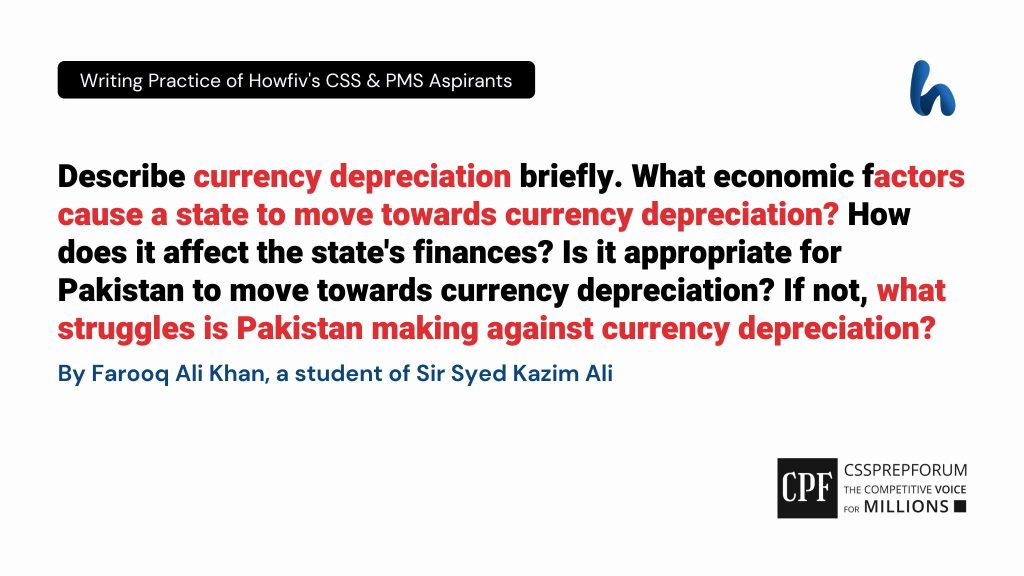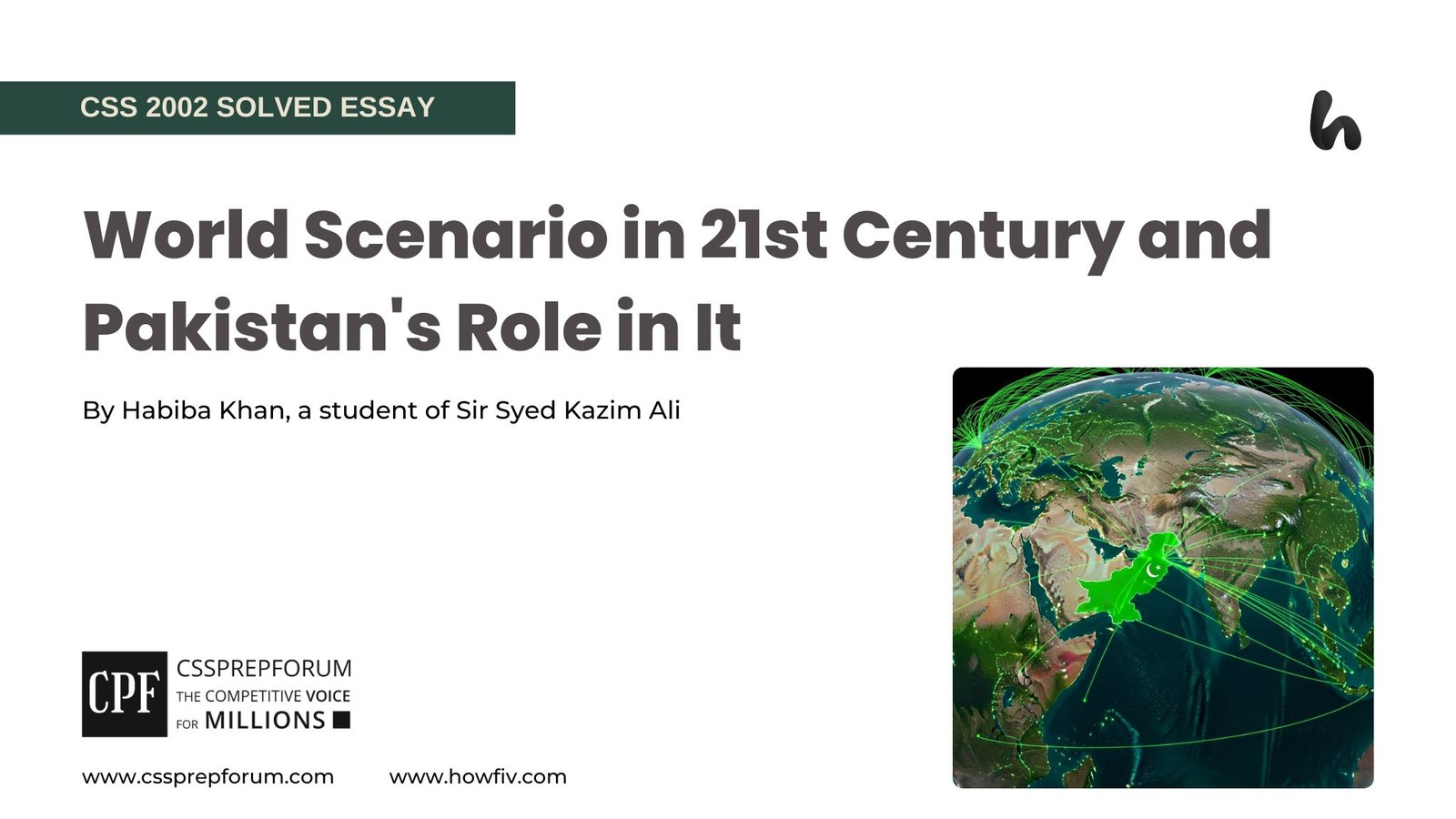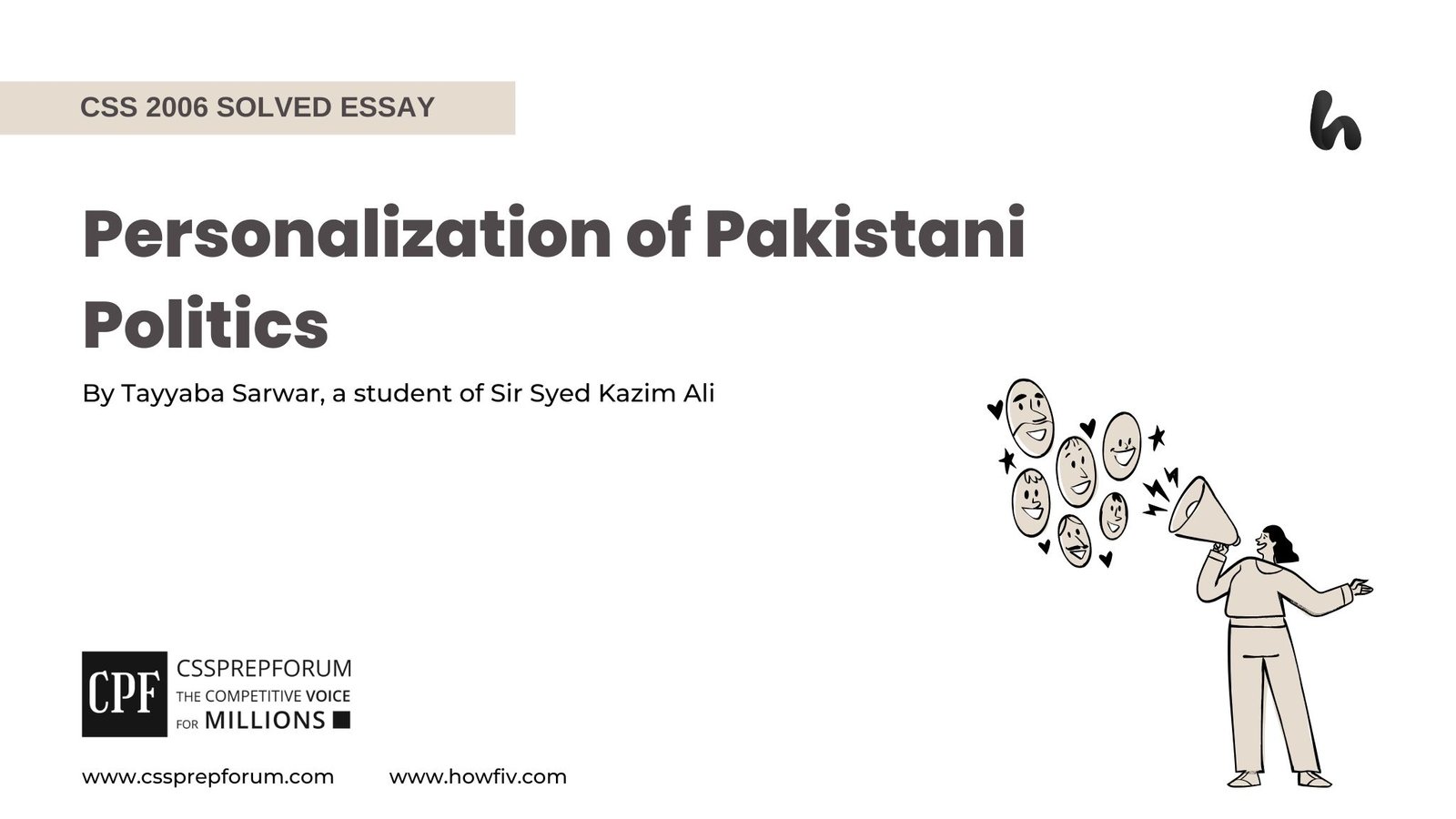Daily Writeup & Opinion | Currency Depreciation and its Relation with Pakistan’s Economy
The following article, “Currency Depreciation and its Relation with Pakistan’s Economy“, is written by Farooq Ali Khan, a student of Sir Syed Kazim Ali. Moreover, the article is written on the same pattern, taught by Sir to his students, scoring the highest marks in compulsory subjects for years. Sir Kazim has uploaded his students’ solved past paper questions so other thousands of aspirants can understand how to crack a topic or question, how to write relevantly, what coherence is, and how to include and connect ideas, opinions, and suggestions to score the maximum.

Outline
1-Introduction
2-Understanding the term ‘Currency Depreciation’
3-Historical background of the dollar vs the rupee
4-Economic factors causing a state to move towards currency depreciation
- ✓ Argument: Incentivizing the inflow of foreign direct investment
- Evidence: China has long been using the strategy of depreciating its currency to increase the inflow of foreign investment.
- ✓ Argument: Maintaining the hegemony of the dollar in the world by the U.S.
- Evidence: The U.S., by increasing the interest rates in their banks, incentivize the inflow of dollar into their banks, making the demand for the U.S. dollar high in other countries that leads to their currency depreciation.
- ✓ Argument: Increasing imports cost to decrease imports from other countries to decrease the current account deficit
- Evidence: Developing countries, including Pakistan, follow this strategy to decrease imports and incentivize import substitution to cope with the surging current account deficit.
5-What made the Pakistani rupee lose its value
- ✓ Argument: Imbalance of trade makes the rupee remain under pressure
- Evidence: The trade deficit of Pakistan stands at -13.87 billion USD and has been soaring very high since the start of the 21st century, making the rupee infirm against the dollar.
- ✓ Argument: A high inflation rate causing a higher fiscal deficit, leading to an increased demand for the dollar
- Evidence: The inflation rate in Pakistan currently stands at seventeen percent and has been changing continuously, changing the value of the dollar against the rupee, signifying that the higher the inflation, the higher the dollar price.
- ✓ Argument: A nation’s central bank has lower interest policies influencing investment towards higher interest areas like the U.S.
- Evidence: The State Bank of Pakistan has lowered the interest rates according to the country’s economic picture, which has greatly impaired the investment by foreign investors.
- ✓ Argument: Low investment confidence leading to a decrease in the dollar inflow and increased dollar demand
- Evidence: Pakistan has been through the phase of low investment confidence, especially since 2013, which further increased the demand for the dollar.
6-How currency depreciation affects a state
- ✓ Argument: Fluctuating exports
- Evidence: Because of a decreased in the yuan’s value in 2019, China’s exports increased, while on the other hand the exports of SAARC countries decreased from 1980s to 2017.
- ✓ Argument: Exacerbating inflation
- Evidence: In 2023, the annual inflation in Argentina reached up to 143%.
- ✓ Argument: Overloading external debt
- Evidence: Since Pakistan has to pay its debt in dollars, the rupee’s depreciation makes it worrisome for Pakistan.
- ✓ Argument: Roaring trade deficit
- Evidence: The total trade deficit of Argentina reached up to 43 billion U.S. dollars in 2023.
- ✓ Argument: Overshadowing informal economy
- Evidence: Pakistan’s informal economy has touched about twenty billion dollars.
- ✓ Argument: Destabilizing political stability in Pakistan
- Evidence: The higher the dollar’s value, the higher the inflation, which ultimately leads to political unrest.
7-Is it appropriate for Pakistan to move towards currency depreciation? Pakistan’s move towards curbing the currency depreciation
- ✓ Banning imports
- ✓ Banning trans-border dollar smuggling
- ✓ Reducing transit through hundi
- ✓ Abolishing human-capita outflow
8-Suggestions to halt currency depreciation
- ✓ To work on Import substitution and add value to exports
- ✓ To manage financial deficit by decreasing imports
- ✓ To incentivize foreign investment
- ✓ To increase the tax-to-GDP ratio
- ✓ To map out better fiscal policies
9-Conclusion

Answer to the Question
In the post-colonial era, all the countries of the world have been in a marathon race to grow economically and achieve sovereignty in a true sense. This race, fortunately, proved to be a blessing for developed countries, for they, owing to their financial policies, have been able to excel in the race. On the other hand, developing countries, due to their decrepit strategies and financial policies, have failed miserably, making them dance to the tunes of developed countries and twist and turn their policies accordingly. And one of the effects that this race has on the developing countries is currency depreciation. Unfortunately, Pakistan, being no exception, is among those developing countries that have faced currency depreciation the most. Moreover, Pakistan’s currency depreciation has not happened in days; rather, it has a very long history of factors behind it, such as inappropriate fiscal policies, trade deficits, informal economy, and global financial factors. Because of currency depreciation, Pakistan has been facing a severe trade deficit, a rise in circular debt, political unrest, and an increase in inflation. On top of that, due to the complexity of the currency devaluation process, every short-term measure that Pakistan took to curb the devaluation of the Pakistani rupee brought lots of other hurdles with it, such as a decrease in exports, increase in inflation, failure to get bailout package from I.M.F. and decrease in FDI. Nonetheless, there is still hope that Pakistan can get through the crisis if it takes some hard and tough measures, such as curbing government expenditures, increasing exports, and import substitution.
Before embarking on how and why currency depreciation affects a state’s finances, it is important to first describe what it actually means. Currency depreciation is a decrease in the value of a currency of a state in comparison to other currencies, usually the dollar. The exchange rate of a country’s currency becomes high, and the country loses its currency’s value versus the dollar and other international currencies. This exchange rate fluctuates from time to time, added to by many domestic and international factors, such as interest rates, fiscal policies, and the political environment of a state.
In 1948, after independence, Pakistan’s banks started issuing their own banknotes. Initially, one dollar was equal to 3.31 PKR. This was, in fact, the lowest exchange rate of the USD and P.K.R. Since then, P.K.R. and the USD have been in flux, changing continuously. In recent years, there has been a tremendous fluctuation in the exchange rate. For instance, the exchange rate started to differ in 1955, and in the 2020s, the rate was astonishingly high: 280. And it did not stop there; the rate has been changing at a very high velocity in recent years, especially the post-pandemic.
Currency depreciation does not occur by itself; rather, there are forces behind it that make the currency lose its value. The reasons are different for different countries. Some countries do it to save from an economic crisis, while some countries opt for it to develop economically. For example, China, the Asian Economic Giant 2019, when the U.S.-China trade war began, devalued its currency to increase its exports by making it cheaper and achieving a place in the international market. On the other hand, China also decreased imports by making imports expensive, which indirectly led to import substitution. In the short term, China’s stock exchange witnessed a drop, but in the long run, China attracted many investors, making China earn billions.
The second reason behind the currency devaluation in many countries is the U.S. trick to value the U.S. dollar by increasing the interest rates; thereby, it decreases the dollar bulk in such countries, making the demand for dollars high. This way, the U.S. maintains the hegemony and value of the dollar in comparison to other currencies. This, in turn, leads to a decrease in the value of other countries’ currencies. Moreover, this strategy has also been implemented by many other developed countries, such as China, Japan, and Germany.
Third, developing countries, such as Pakistan, devalue their currency to cope with their trade deficits and current account deficits. Thus, by devaluing their currency, they decrease their imports, which helps them stabilize their current accounts. Pakistan, in the post-pandemic era, especially in 2024, as stated in the economic survey of Pakistan, decreased its current account deficit by 3.6 Billion U.S. dollars up to 0.2 Billion dollars. Moreover, it also helps them move towards import substitution. Thus, in order to maximize exports and decrease imports, developing countries and some developed countries adopt this strategy.
Moreover, the Pakistani rupee has experienced the same fate owing to many domestic and international financial issues. First, the imbalance of trade, increased imports and decreased exports, has made the rupee sink deep. According to an economic survey of Pakistan, Pakistan decreased its trade deficit to 17.7 billion U.S. dollars compared to 22 billion U.S. dollars in 2023. Furthermore, Pakistan increased its exports by 25.7%. This shows how the currency, along with some international financial changes, helped Pakistan counter its surging trade deficit.
Second, inflation has a direct relation with currency devaluation. Whenever there is an increase in the value of the dollar in a local market, inflation ultimately increases with it, too. For instance, in 2023, inflation in Pakistan was recorded at 38%, and the dollar rate was 285 PKR per dollar. To further explain it, inflation decreased when the value of the dollar decreased in the local market in Pakistan. This relationship between the dollar and the P.K.R. emphasizes how related the U.S. dollar and P.K.R. are. Thus, the higher the dollar price, the higher the inflation in a country.
Third, Pakistan has also been through currency depreciation because of the policies of the State Bank of Pakistan. Unlike the U.S.A., which increased the interest rates in their local banks to attract people to save dollars there, Pakistan’s banks lowered the interest rates to twenty per cent. This strategy has diverted many people to save their money in those countries where they are offered more interest rates. This decreased the dollar’s bulk in Pakistan and indirectly increased its demand, thereby leading to currency devaluation.
Fourth, since 2013, Pakistan has been through a phase of low investment confidence, which badly impacted its economy. This also added to the fiscal deficit and the current account deficit. Investment bears great importance for a country’s economic might. Unfortunately, Pakistan goes the other way. It has experienced a very low investment confidence which decreased the dollar inflow greatly, thereby impacting its currency, which decreased because of the high demand of dollar because of low dollar bulk secondary to low investment confidence.
Furthermore, currency depreciation has profound effects on the countries that willingly or unwillingly devalue their currencies. However, the effects are different for different countries. For instance, when China, after the U.S.-China trade war, devalued its currency, the exports of China surged very high because it increased its exports by making exports cheaper for the foreign countries and made imports expensive to flourish its own industrial sector. Contrastingly, the exports of SAARC countries could not increase; in fact, they decreased their exports by many points. This shows how currency depreciation and its effects depend upon the country which does it.
Second, the devaluation of the currency also has effects on the consumer price index and total inflation. In fact, inflation and currency devaluation alternate in a vicious cycle, with one following the other. For instance, Argentina, in 2023, witnessed annual inflation of about 143% owing to their currency devaluation. The same is the case with Pakistan, where inflation and currency devaluation go hand in hand. This vicious cycle continues with increasing velocity, making the condition more cumbersome.
Third, an increase in the external debt of a country is another malignant problem associated with currency devaluation. The more devaluation of the currency, the more external debt there is. According to a survey, Pakistan’s external debt increased by one billion dollars due to currency devaluation and increased interest rates, as Pakistan had to pay more rupees in exchange for dollars to pay off its debt. This way, Pakistan’s external debt increased by many folds, putting pressure on its already sinking economy. This is how currency devaluation makes the debt of a country grow high.
Fourth, the devaluation of the currency also carries with it an increase in the trade deficit of a state. It makes imports expensive, and the state has to pay more for the same quantity of goods. Moreover, the imports of raw materials to a state’s industrial sector also decrease, leading to decreased productivity. This indirectly decreases exports, thereby leading to a trade deficit. For instance, Argentina witnessed a trade deficit of forty-three billion dollars in 2023, owing to its currency devaluation. Pakistan has also been through a trade deficit of forty-five billion dollars in 2021 when the dollar rate was soaring. Thus, it can be said that there is a strong interconnection between the two.
Fifth, currency devaluation also provides fertile soil for the informal economy to thrive. Most of the remittances then come to a country via the Hundi and Hawala system to escape taxation and other government authorities. Pakistan is a very good example of it. Here, the hundi system gives higher rates than the government banks. Also, people in Pakistan try to escape the taxation net via this route. This, directly and indirectly, gives rise to the informal economy, which is, according to a survey, twenty billion dollars, and it is still on a rising trend. Although the informal economy not only contributes to currency depreciation, many other domestic policies also contribute to it, and the link between the informal economy and currency depreciation is not negligible.
Last but not least, political instability has been the most important factor in deciding the exchange rate. All those countries that suffer from political instability also experience currency depreciation. The former leads to low investment confidence, low foreign aid, low I.M.F. bailouts, and many other reasons. These factors indirectly lead to low foreign reserves and higher fiscal and current account deficits, which in turn lead to an increase in the demand for the dollar, making its exchange rate higher. Again, Pakistan can be presented as a perfect example of this scenario. In the 2020s, because of political instability, the dollar touched the sky, ranging from 250 to 300. Moreover, during times of political stability, there comes an increase in investment and others that, in turn, lead to a decrease in the demand for dollars and decreased financial deficits. Thus, one can say that the higher the political instability, the higher the dollar rate.
Furthermore, currency depreciation has been a hot issue in the twenty-first century. Many governments, such as the U.S. and China, have been involved in the game intentionally for their benefit despite not being recommended by the International Financial Institutions, while some developing countries, un-willingly, get involved. Even in Pakistan, the issue has been talked about a lot. However, for Pakistan, if it goes for currency depreciation, it might cause its exports to decrease, as happened with other SAARC countries. Second, the country has already been overshadowed by high inflation, and this might further exaggerate the condition. Third, the already acarpous political shape of the country might become more dark and unstable. Fourth, Pakistan might sink into the deep sea of soaring external debt, which might be impossible for Pakistan to cope with. Last but not least, Pakistan might suffer from a very strangulating economic crisis exacerbated by high fiscal and current account deficits. These reasons suggest Pakistan should not go towards currency depreciation.
Granted that it is not high time for Pakistan to move towards currency depreciation, It witnessed currency devaluation the most, especially during the twenty-first century. In the post-COVID era, secondary to floods in 2022 and the Global financial crisis, Pakistan’s G.D.P. dropped to 0.5 % from 6.8%. Moreover, its exports and imports went through an imbalance; the fiscal deficit and the current account deficit became high, and the agriculture sector also witnessed a sudden fall. All these factors forced Pakistan to take some scrupulous measures. Some of these measures were banning imports to save dollars, which, in the short term, decreased Pakistan’s current account deficit and somewhat stabilized the trade deficit. For instance, the trade deficit decreased from forty-five billion dollars to seventeen billion dollars. Exports also decreased by 3.6 billion dollars. Also, it banned the outflow of human capital to save dollars. Further, it banned the inter-border smuggling of dollars through the Pak-Afghan border and other things. In addition, it also took some measures to check transactions through the Hundi/hawala system. Critically, although these measures helped for a while, they pushed Pakistan into further crises, be they economic, social, or political.
Currency depreciation, however, affected Pakistan in so many ways, but the condition can still be ameliorated if certain conscientious steps are taken in time. For instance, Pakistan should work on its own industries, incentivizing the industrial sector to increase its exports and decrease the need for imports. The Development Ministry should put forward policies that are best suited to Pakistan’s environment and are accepted by industrialists. This way, Pakistan can alleviate fiscal and current account deficits. This will directly stabilize the exchange rate and that will help Pakistan’s economy.
Second, Pakistan, as it already did in the post-pandemic area, should ban the imports of luxurious goods. The government should scrutinize the imports and only allow those goods and raw materials that are required for industries to avoid economic slowdown.
Third, Pakistan should incentivize investment as done by Switzerland by making the investment procedure easy and appealing for the investments. Although the former has launched SIFC, which is doing its best: it attracted the U.A.E., Qatar, and the K.S.A., it should further promote and make the soil for investment fertile to attract foreign investors.
Last but not least, the government should also work on out-of-the-box solutions, like increasing tax-to-GDP ratio, value addition to exports and working on the service sector. These steps helped Scandinavian countries in a long run. For instance, Luxembourg, Denmark, Singapore, and many other countries made it into the list of developed countries, owing to their commitments to the former strategy.
In conclusion, it is true that currency depreciation has a number of impacts on the finances of a state. However, the impacts vary from country to country. For some countries, like the U.S.A. and China, it boosts their economies, while for some countries, like SAARC countries, it negatively affects them, decreasing their exports and increasing their deficit. Pakistan, being no exception, has faced the same problem, proving that currency devaluation has only brought a bad fate to the country. And to counter it, Pakistan took some short-term and immediate steps that further exacerbated its financial crisis. Withal, all is not dark yet; Pakistan, if it adopts the carrot and stick strategy, like allowing only necessary goods to be imported, incentivizing investment and industrialization, and rational fiscal policies, can come out of the crisis successfully.

CSS Solved Past Papers’ Essays
Looking for the last ten years of CSS and PMS Solved Essays and want to know how Sir Kazim’s students write and score the highest marks in the essays’ papers? Then, click on the CSS Solved Essays to start reading them.
CSS Solved Essays
CSS Solved General Science & Ability Past Papers
Want to read the last ten years’ General Science & Ability Solved Past Papers to learn how to attempt them and to score high? Let’s click on the link below to read them all freely. All past papers have been solved by Miss Iqra Ali & Dr Nishat Baloch, Pakistan’s top CSS GSA coach having the highest score of their students.
General Science & Ability Solved Past Papers












